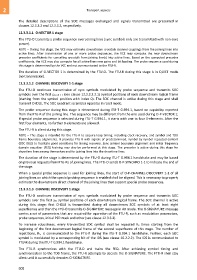Page 918 - 5G Basics - Core Network Aspects
P. 918
2 Transport aspects
The detailed descriptions of the SOC messages exchanged and signals transmitted are presented in
clauses 12.3.3.2 and 12.3.3.3, respectively.
12.3.3.1.1 O-VECTOR 1 stage
The FTU-O transmits a probe sequence over joining lines (sync symbols only are transmitted with non-zero
power).
NOTE – During this stage, the VCE may estimate downstream crosstalk channel couplings from the joining lines into
active lines. After transmission of one or more probe sequences, the VCE may compute the new downstream
precoder coefficients for cancelling crosstalk from joining line(s) into active lines. Based on the computed precoder
coefficients, the VCE may also compute for all active lines new gains and bit loading. The probe sequence used during
this stage is determined by the VCE and not communicated to the FTU-R.
The duration of O-VECTOR 1 is determined by the FTU-O. The FTU-R during this stage is in QUIET mode
(no transmission).
12.3.3.1.2 CHANNEL DISCOVERY 1-1 stage
The FTU-O continues transmission of sync symbols modulated by probe sequence and transmits SOC
symbols over the first sds-CD-1-1 (see clause 12.3.3.3.3.1) symbol positions of each downstream logical frame
(starting from the symbol position with index 0). The SOC channel is active during this stage and shall
transmit O-IDLE. The SOC quadrant scrambler operates in reset mode.
The probe sequence during this stage is determined during ITU-T G.994.1, based on capability reported
from the FTU-R of the joining line. This sequence may be different from the one used during O-P-VECTOR 1;
if special probe sequence is selected during ITU-T G.994.1, it starts with one to four 0-elements. After the
first four elements, no further 0-elements are allowed.
The FTU-R is silent during this stage.
NOTE – This stage is intended for the FTU-R to acquire loop timing, including clock recovery, and symbol and TDD
frame boundary alignments. It provides FTU-R with signals of predetermined, symbol-by-symbol repeated content
(SOC IDLE) to facilitate good conditions for timing recovery. Sync symbol boundary alignment and initial frequency
domain equalizer (FEQ) training may also be performed at this stage. The precoder is active during this stage for
showtime lines among themselves and for joining lines into the showtime lines.
The duration of the stage is determined by the FTU-O during ITU-T G.994.1 handshake and may be based
on previous requests from FTU-Rs of joining lines. The FTU-O sends O-P-SYNCHRO 1-1 to indicate the end of
the stage.
When a special probe sequence is used for joining lines, the start of O-P-CHANNEL-DISCOVERY 1-1 of all
joining lines on which the special probing sequence is enabled shall be aligned. This is necessary to properly
estimate the downstream direct channel of the joining lines that support special probe sequences.
12.3.3.1.3 CHANNEL DISCOVERY 1 stage
The FTU-O continues transmission of sync symbols modulated by probe sequence and transmits SOC
symbols over the first sds symbol positions of each downstream logical frame. The SOC channel is active
during this stage; first O-IDLE is transmitted during all downstream SOC symbols of at least eight
superframes and then the FTU-O transmits O-SIGNATURE message in AR mode. The O-SIGNATURE message
carries a set of parameters that are required for operation of the FTU-R, such as modulation parameters,
probe sequences, initial PSD mask and other (see clause 12.3.3.2).
To increase robustness, every transmitted SOC symbol shall be repeated RS times starting from the
beginning of the first downstream logical frame of the second superframe of this stage. The number of
repetitions, RS, is communicated to the FTU-R during the ITU-T G.994.1 handshake. Further, each SOC
symbol is modulated by a corresponding bit of the IDS (see clause 10.2.2.2). The IDS is communicated to
FTU-R during the ITU-T G.994.1 handshake.
The FTU-R synchronizes with the FTU-O and trains the FEQ. After achieving symbol timing and
synchronization to the TDD frame, the FTU-R attempts to decode the O-SIGNATURE. The FTU-R shall stay
silent until it successfully decodes O-SIGNATURE.
908

